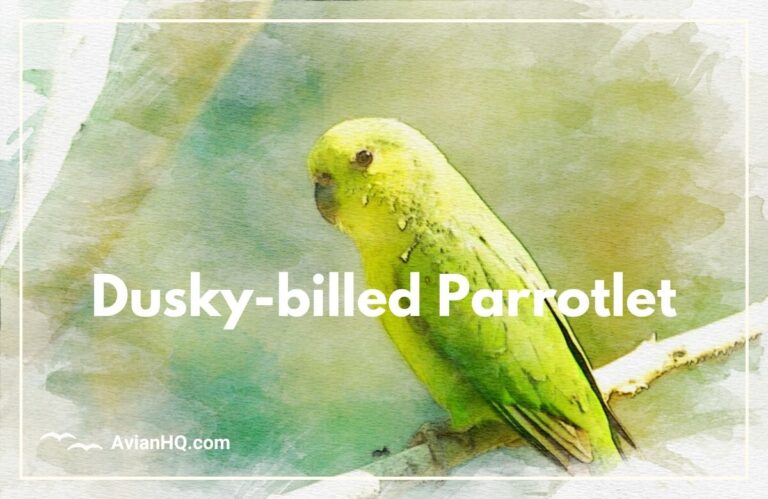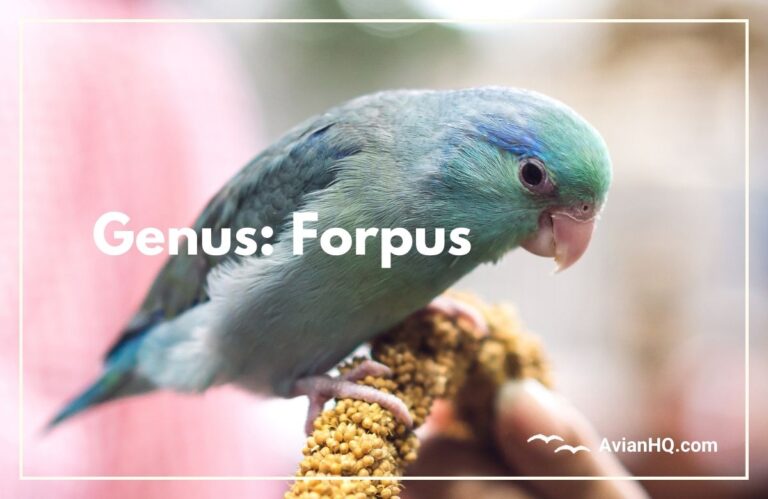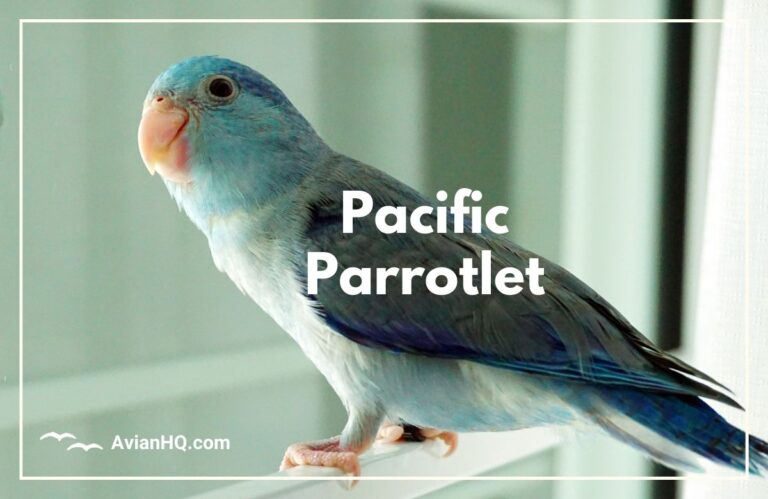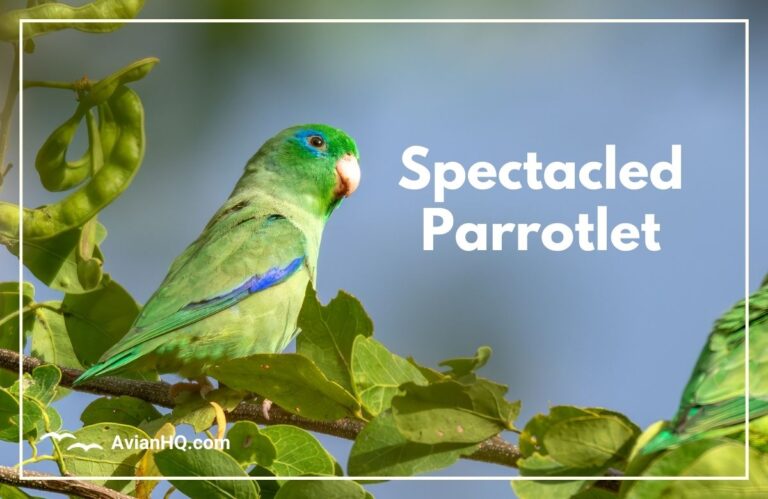Riparian Parrotlet (Forpus crassirostris)
You gaze up into the dense green canopy of the tropical forest. A flash of bright green and yellow darts by. It’s a Riparian Parrotlet! This vibrant little bird is one of the smallest parrots in the world, weighing less than 1 ounce (25 grams).
As its name suggests, the Riparian Parrotlet lives along rivers and streams in the tropical forests of northwestern South America. Specifically, it’s found in parts of Colombia, Ecuador, Peru, and Brazil.
These tiny parrots perfectly blend in with the rainforest leaves. Adults are mostly green with bright yellow patches on their wings, abdomen, and rump. Their wings measure just 3.5 inches (9 cm) but allow them to maneuver gracefully through vegetation near the water.
Fun Fact: The Riparian Parrotlet is also called the Santa Marta Parakeet due to the Santa Marta mountains being part of its native range.
The males and females look alike, outside of size. Females tend to be slightly larger in dimensions. Their stout, hooked bills give you a clue that these little parrots love fruit and seeds.
In this article, you’ll learn all about the natural history of these charming birds, including their unique adaptations to riverbank habitats and impressive climbing abilities on slender branches. We’ll also cover why they are listed as endangered and what conservation efforts aim to preserve them.
So get ready to meet one of the most spectacular tiny parrots on Earth!
History and Taxonomy
The Riparian Parrotlet’s scientific name is Forpus crassirostris. It has a rather recent history among newly classified bird species.
Ornithologist José Yepes first described the parrotlet in 1947, based on specimens collected along the Sinú River in northern Colombia. For a long time it was considered a subspecies of the Dusky-billed Parrotlet until elevated to full species status in 1997.
Its genus name Forpus refers to a small parrot or parakeet. The species name crassirostris highlights this parrotlet’s notably thick, heavy bill compared to relatives. Taxonomists place the Riparian Parrotlet in the following classification:
Kingdom: Animalia
Class: Aves
Order: Psittaciformes
Family: Psittacidae
Genus: Forpus
Species: Forpus crassirostris
The Psittacidae family contains 392 species of parrots and parakeets, making it one of the most diverse bird families. The Forpus genus includes eight species of small Neotropical parrotlets, predominantly green in color. The Riparian Parrotlet stands out with its vibrant yellow markings on the body and wings.
Some taxonomists consider the separate “Lara’s Parrotlet” to be the same species. However, Lara’s has distinct plumage and occupies drier forests farther north. Most experts still classify it as Forpus xanthops.
Physical Appearance
The Riparian Parrotlet is a tiny, mostly green parrot with striking yellow patches. It measures around 4 inches (10 cm) long from head to tail tip.
Adults weigh an average of 0.8 ounces (24 grams), which is lighter than a golf ball! Their wingspan reaches just 8-9 inches (20-24 cm). So these petite parrots are one of the smallest species of true parrot.
Their main body plumage color is bright, grass green. A yellow-olive band runs across the forehead right above the curved bill. More vibrant yellow feathers cover the thighs, belly, rump area, and wing patches. The yellow contrasts nicely with the green.
Males and females look nearly identical, with females being almost unnoticeably larger in body and bill size. Juveniles start out duller in coloration with some dark scalloping on their plumage until they molt into adult feathers.
Riparian Parrotlets have stout, thick beaks that open wide when eating fruit. The upper bill tip overhangs the bottom. Their irises are typically brown while their feet range in color from pale pink to nearly black.
When perched, these parrotlets have a rounded, almost chunky appearance. But theytransform gracefully into agile flyers to travel between forest trees and riverbanks. Their blunt tail and pointed wings help reveal them in flight.
Habitat and Distribution
The Riparian Parrotlet inhabits tropical lowland forests and woodlands, primarily near rivers and streams. Its range covers parts of four South American countries.
This species lives along waterways at elevations up to 3,000 feet (914 meters) above sea level. It prefers forests with tall, mature trees along with vines, epiphytes, and dense undergrowth. Palm trees often fringe its habitat.
The Riparian Parrotlet is endemic to northern South America, found in:
- Northwestern Colombia
- Northern Ecuador
- Northeastern Peru
- Parts of western Brazil
Most of its global population resides within the Magdalena and Sinú Valleys in Colombia, which harbor important Remnants of intact forest. Peru’s Tumbes region marks its southern range limit.
These parrotlets always live close to water bodies, seldom venturing over 1 kilometer (0.6 miles) away from a riverbank or stream edge. They especially favor slow moving black-water rivers flowing through rich alluvial soils.
Year-round, they occupy lowland rainforests below 1,000 feet (300 meters) elevation near the Andes foothills. During wet seasons when rivers flood, they disperse more widely into adjacent swamp forests and secondary growth woodlands.
Diet and Feeding
The Riparian Parrotlet enjoys a diverse fruit- and seed-based diet. Its unique thick bill and feet help it access various forest foods.
This species forages actively through vegetation in the forest canopy. It uses its sturdy bill to crack open hard nuts and fruits to reach the tasty seeds inside.
Some of its favorite wild foods include:
- Figs
- Nuts from palm and guarumo trees
- Fruit from Cecropia and melastome shrubs
- Seeds of canopy vines and epiphytes
Riparian Parrotlets constantly employ their strong feet and legs to climb through branches. Their toes arrange in a zygodactyl pattern, with two toes facing forward and two facing backward to grip effectively.
These agile parrots walk along vines and tree limbs with ease to find fruit. They also hang upside-down or sideways at times while feeding. Their versatile bills allow them to extract insects hiding in crevices as a supplementary protein source.
In captivity, their diet consists of a nutritionally balanced mix of fruits, vegetables, nuts, seeds, and pellets. Favorites include apples, corn, and sunflower seeds.
Breeding and Reproduction
The breeding habits of the Riparian Parrotlet align with the rainy season of its tropical habitat. Breeding pairs nest in tree cavities and can produce several broods per year.
Breeding occurs during the wettest months from February to August. Courtship starts with males performing bobbing motions and vocal duets with prospective mates. Once bonded, the monogamous pair remains together for the long term.
Nesting Sites
Riparian Parrotlets nest in natural tree cavities or old woodpecker holes located around 16-65 feet (5-20 meters) above ground. They prefer holes with very narrow entrances in dead palms. The female scrapes away wood shards inside to create a smooth nursery chamber.
Clutch Size
Females lay between 3-5 tiny white eggs per clutch. On average, the tiny eggs measure 0.8 inches (20 mm) long. She incubates them alone for about 24 days while the male brings her food.
Offspring
Hatchlings are altricial, meaning naked and helpless at birth. Both parents feed regurgitated food and defend the nest until fledging at 5-6 weeks old. The youngsters leave the nest but stay near their parents in a family group as they learn to forage.
Broods
In one breeding season, a Riparian Parrotlet pair can successfully raise 2-3 broods. Their ability to produce many offspring each year helps balance losses to predation and habitat pressures in the wild.
Behavior and Ecology
The Riparian Parrotlet exhibits active, social behaviors suited to life in tropical river forests. Its unique adaptations help it thrive in treetop and edge habitats.
Daily Activity
These birds stay busy all day foraging, climbing, preening, and interacting. They become active at dawn, spending the mornings and afternoons searching for food. Around midday they may rest briefly to avoid the heat. Riparian Parrotlets travel in small flocks of 6 to 12 green birds while feeding. Just before dusk they bathe and drink before settling into roost cavities for the night.
Social Structure
Riparian Parrotlets live in social groups with complex dynamics. Several mated pairs often associate with other juveniles and adults in a larger flock. They groom each other frequently as gestures of bonding and affection. Flocks roost communally each night inside a tree hole or palm cluster.
Vocalizations
From dawn until dusk, Riparian Parrotlets make a range of squealing, chattering sounds. Their primary call is a sharp, rolling “prreet” note. So their groups produce almost constant noise! Soft warbling indicates contentment during preening or resting periods.
Foraging Adaptations
This parrotlet’s unique thick bill easily cracks hard nuts and fruits. Its sturdy zygodactyl feet allow climbing any direction on branches. It even hangs upside-down at times while feeding. These useful adaptations maximize its access to various forest foods.
Conservation Status
Due to ongoing habitat loss and capture for the pet trade, the Riparian Parrotlet is classified as Endangered by the IUCN Red List.
Its global population is estimated between 1,000-2,500 mature individuals. Many local subpopulations are now isolated as lowland forests get cleared for agriculture and logging.
This species has vanished entirely from parts of its former range. For example, Riparian Parrotlets no longer occur in Ecuador’s Esmeraldas province where habitat degradation runs rampant. Other small pockets persist near villages. But these groups face pressure from illegal poaching.
Trapping wild parrotlets for local bird markets still threatens the species in some regions. Colombia banned their export in the 1970s but illegal trading continues. Peru only recently prohibited harvesting wild individuals in 2017.
On a positive note, aviculturists have successfully bred Riparian Parrotlets in captivity. A network of conservation centers now strategically houses captive flocks to buffer the endangered wild populations. These programs aim to eventually reintroduce captive-raised birds at suitable protected sites.
Further actions urgently needed involve guarding remaining habitat fragments and creating forest reserves along key watersheds they occupy. Continued monitoring should track wild populations to guide management efforts.
Cultural Significance
The vibrant colors and playful nature of the Riparian Parrotlet make them popular as pets. Local indigenous groups also view these birds as symbols of river health.
Pets
Riparian Parrotlets are delightful and interactive companion birds when domestically raised. Their affectionate bonds and flocking nature suit them well to family life. Captive pet parrotlets live 15-20 years with proper care and diet.
Avicultural breeding programs aim to establish healthy captive populations as an “insurance” safeguard while wild numbers decline. Hand-tamed pet parrotlets also garner more awareness and funding for continued conservation projects abroad.
Indigenous Peoples
Native peoples dwelling near Raparian Parrotlet habitat regard the tiny parrots as indicators of forest quality near water sources. The birds need intact mature trees for nesting and feeding. So their presence signals healthy vegetation and water purity important for communities too.
Seeing or hearing flocks pass by reminds locals of the close ties between forest, fauna and people. But current rates of habitat destruction now threaten the sustainability of these rich ecosystems and the culture interwoven with them.
Ecotourism Potential
Birdwatchers beginning to visit remnant habitats bring appreciation and small-scale tourism revenue. Riparian Parrotlet range countries could carefully develop this specialty niche for rural economies through sustainable guided tours. These efforts would also incentivize further habitat protection.
Conclusion
The vibrant little Riparian Parrotlet has adapted well to life along tropical lowland rivers and streams. Its unique features allow it to extract fruit and nuts efficiently. And the species exhibits impressive climbing skills and strong social bonds.
Yet continuing destruction of South American rainforests now threatens these birds. The IUCN Red List classifies them as Endangered due to trafficking, small isolated populations, and habitat loss.
Conservation centers have succeeded with captive breeding efforts to bide time. But preserving remaining wild habitat corridors is critically urgent for the species to rebound. Local communities can also aid their survival by sustainably using forest resources.
With robust protected forests linked by key rivers they depend on, Riparian Parrotlets stand a fighting chance. This charming bird still has huge potential as an engaging ambassador to showcase the interconnectedness of local faunas and human welfare through healthy environments. Their future now rests on collaborative restoration initiatives between scientists, governments and indigenous groups across northern South America.






